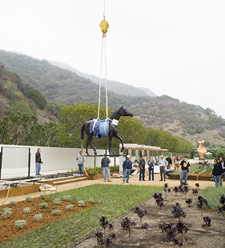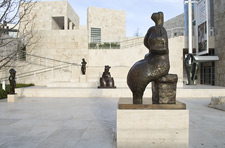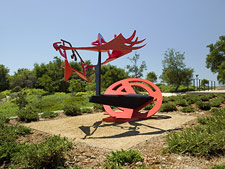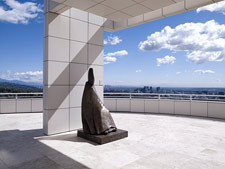A major transformation of the Getty Center has taken place with the installation of 28 modern and contemporary outdoor sculptures donated to the J. Paul Getty Museum from the collection of the late legendary film producer Ray Stark and his wife, Fran.
Joining Martin Puryear's That Profile and Robert Irwin's Central Garden, the sculptures are located throughout the site and are integrated with the environment and architecture to create a dramatic outdoor art experience.
The Fran and Ray Stark Sculpture Garden
Located at the foot of the hill, at the tram departure area where visitors first enter the Getty Center, is a concentration of British sculpture, including Elisabeth Frink's Horse and Running Man and Henry Moore's Bronze Form and Draped Reclining Mother and Baby, as well as American and Spanish sculpture such as Isamu Noguchi's Tent of Holofernes, and Peter Shelton's bronzenightshirt, and Joan Miró's Figure.

|
 |
Elisabeth Frink's Horse is carefully lowered into place in its new home in the Fran and Ray Stark Sculpture Garden
© Estate of Elisabeth Frink
|
|
 |
This new space consists of intimate and peaceful outdoor gallery rooms designed to promote contemplation or conversation.
The Fran and Ray Stark Sculpture Terrace
Adjacent to the Museum's West Pavilion, outside the entrance to the Center for Photographs, is the Stark Sculpture Terrace, with works that depict the broad outlines of figurative sculpture's move from representation to abstraction. Included here are Barbara Hepworth's Figure for Landscape and Henry Moore's Seated Woman, among others.
Other Sculpture around the Site
In addition to the two named areas, you will encounter sculpture in various public spaces and gardens. Aristide Maillol's Air is located on the Museum's grand staircase; Alberto Giacometti's Standing Woman I in the Museum's Entrance Hall.
At the southern end of the Museum Courtyard, look for Ellsworth Kelly's Untitled. Jack Zajac's Big Skull and Horn in Two Parts II and Roy Lichtenstein's Three Brushstrokes are situated on the Getty Research Institute plaza.
 |

|
| |
The Fran and Ray Stark Sculpture Terrace, with Henry Moore's Seated Woman in the foreground
© The Henry Moore Foundation
|
 |
After crossing Central Garden by Robert Irwin, you'll find the Lower Terrace Garden overlooking Los Angeles and featuring six sculptures, including the kinetic, wind-activated Three Squares Gyratory by George Rickey.
On the second-floor level outside the Museum's South Pavilion, Saul Baizerman's Night, Giacomo Manzù's Seated Cardinal and several other sculptures animate the South Terrace.
Getting Ready
In creating the new outdoor spaces, the Getty worked with Richard Meier and Partners, the original architects of the Getty Center, and with the Olin Partnership, the site's original landscape designers, to develop and prepare areas throughout the Getty Center for the installation of the modern works.
Audio by Phone, Web, and iTunes
Prepare for your visit, or visit virtually! Listen to sculptors Joel Shapiro, Jack Zajac, and Peter Shelton talk about their work. Hear a Getty Museum conservator, a designer, and curators as they share their views about the sculpture, sculpture gardens, and the planning and work involved to make it all happen. Art historian Penelope Curtis of the Henry Moore Institute is also featured.
There are many ways to listen:
Listen to the audio tour on this Web site.
Download the audio to listen on your iPod or other MP3 player (19 MP3 files, 20 MB total).
 Listen to the audio as a podcast using iTunes. (Podcast help)
Listen to the audio as a podcast using iTunes. (Podcast help)
 Listen as a podcast by subscribing to the RSS feed. (Podcast help)
Listen as a podcast by subscribing to the RSS feed. (Podcast help)
 You can also listen to the audio tour from your own phone, now or during your visit to the Getty Center. Download the cell phone tour guide (PDF, 194 KB), which shows the codes for each sculpture on the audio tour. Call (310) 499-9236 and, at the prompt, enter the code for the sculpture that interests you. You can also pick up the cell phone tour guide free at the Museum Information Desk.
You can also listen to the audio tour from your own phone, now or during your visit to the Getty Center. Download the cell phone tour guide (PDF, 194 KB), which shows the codes for each sculpture on the audio tour. Call (310) 499-9236 and, at the prompt, enter the code for the sculpture that interests you. You can also pick up the cell phone tour guide free at the Museum Information Desk.

|
 |
Mark di Suvero's Gandydancer's Dream is one of several dramatic sculptures in the Lower Terrace Garden
Courtesy of Mark di Suvero and Spacetime C.C.
|
|
 |
About the Donors
The Stark collection comes to the Getty Center through a generous donation by the trustees of the Fran and Ray Stark Revocable Trust.
The late legendary film producer Ray Stark and his wife, Fran, had a passion for art that led to a fine collection of modern works with a focus on sculpture. Ray Stark died in January 2004, twelve years after Fran Stark's death.
Ray Stark is best known as the producer of such classic films as The Night of the Iguana, The Way We Were, The Goodbye Girl, Reflections in a Golden Eye, and Funny Girl, which was based on the life of pioneering comedienne Fanny Brice, Fran Stark's mother.
The installation at the Getty Center makes the collection permanently accessible to the people of Los Angeles, the city where the Starks made their home for more than 60 years.



Listen to the audio as a podcast using iTunes. (Podcast help)
Listen as a podcast by subscribing to the RSS feed. (Podcast help)
You can also listen to the audio tour from your own phone, now or during your visit to the Getty Center. Download the cell phone tour guide (PDF, 194 KB), which shows the codes for each sculpture on the audio tour. Call (310) 499-9236 and, at the prompt, enter the code for the sculpture that interests you. You can also pick up the cell phone tour guide free at the Museum Information Desk.
